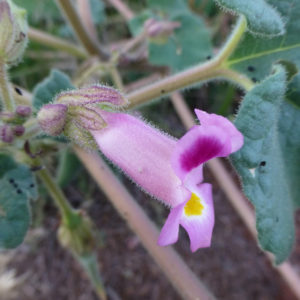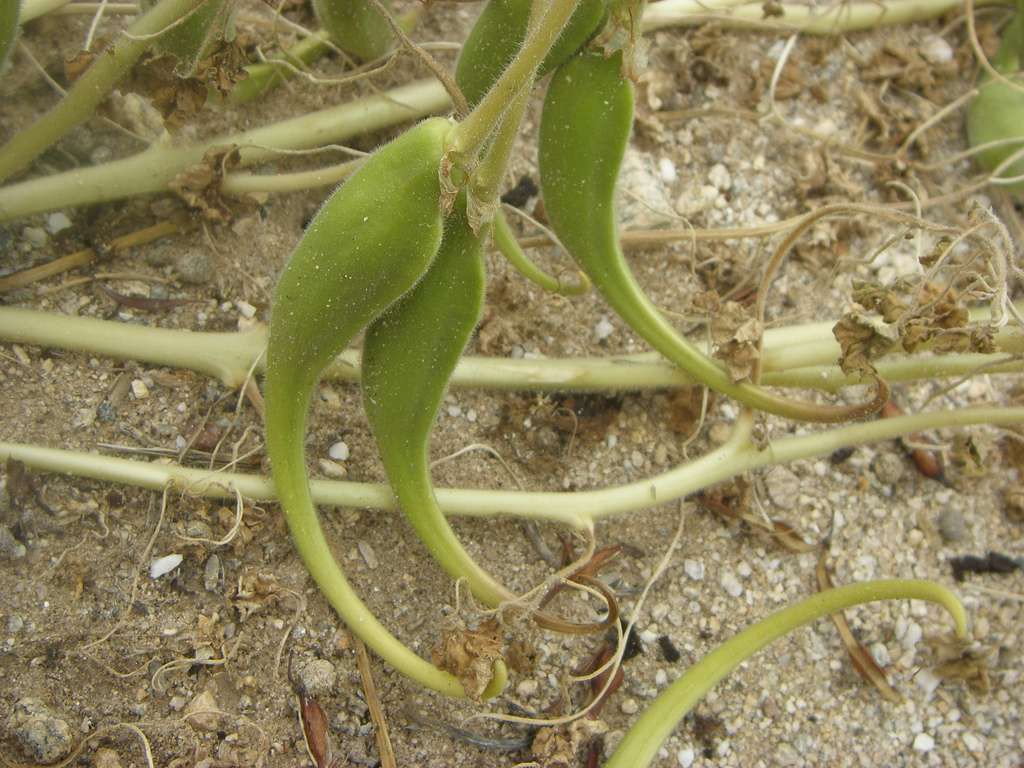Scientific name: Proboscidea parviflora
Common names: doubleclaw, devil’s claw, unicorn plant
Family: Pedaliaceae (Sesame family, formerly Martyniaceae)
Article by Jeanne Gozigian
There is nothing that I love better than a good mystery! Curled up in my comfy recliner chair and covered with a fleece throw on a cold December day, with a Nero Wolfe by Rex Stout or an Agatha Christie’s, Monsieur Poirot, is my idea of heaven.

Proboscidea parviflora. Photographer: Max Licher
Manager: ASU Vascular Plant Herbarium
Locality: Red Rock Loop Road, Sedona. SEINet Portal Network. 2018. http//:swbiodiversity.org/seinet/index.php. Accessed on November 28.
But, perhaps more exciting, is a botanical mystery. What was that beautiful, isolated clump of pink, trumpet shaped flowers sporting geranium-like leaves that I spied growing near my house, adjacent to the Rio Grande Bosque, in July and August of 2018? I took pictures and sent them off to my fellow “plant nuts,” after I thought that I had researched all pink trumpets in the American southwest. Guesses were made but the definitive answer came from Scott Canning, Horticulture and Special Projects Director at the Botanical Garden at Museum Hill in Santa Fe, New Mexico. He declared it to be Proboscidea parviflora in the Sesame family, eerily known as a horse and cow crippler.
This annual is fairly rare with good reason; its sturdy split seed pod with long, vise like tentacles, can piggyback on the hooves of deer, cattle or horses to propagate the species, meanwhile causing damage to their legs and hooves. I followed it through the season when the flowers segued to the fleshy fruits, said to be able to be cooked and eaten like okra. Looks like local rabbits or whatever thought so, too. I took some pictures and when I next studied the plants, all of the fruits were gone. The next observation saw the total elimination of the plant cluster. My dreams of obtaining a mature seed pod were over. So much for “stalking” the plant; on to book and internet plant research.
A good part of the mystery of botanical research is “de-mystifying” the origin of plant names. Carl Linnaeus (1707-1778), the great Swedish botanist, gave us the binomial system for classifying plants and animals, using the Latin language. The family name, Pedaliaceae, is from the Latin (pedalis) that refers to the size of a group of plants that are one foot or 30 cm. in length or height. More mystery – P. parviflora is definitely more than one foot in length and height. The former family name, Martyniaceae, is in honor of John Martyn (1699-1768) a London physician and professor of botany at Cambridge, England. It is certainly no mystery that doctors were often botanists; e.g. America’s Dr. David Hosack (1769-1835) who developed the first botanical garden in the United States on 20 acres of Manhattan farmland where now stands Rockefeller Center. Plant medicines were the pharmacopeia from which doctors/botanists drew to treat illnesses before modern “miracle” medicines.
Proboscidea (pro-bosk-ee-DEE-uh) is from the Greek, proboskis, an elephant’s trunk – shaped like a snout – while parviflora (par-VEE-flor-uh) means small flowers, from the Latin prefix, parvi- small, adding to the mystery of doubleclaw. The trumpet flowers do not conform to what we would usually call small-flowered plants. But proboscis makes sense; the fruit of devil’s claw does resemble a snout before it dries into the formidable two-sided seed pod.

Photographer: Anthony Mendoza. SEINet Portal Network. 2018. http//:swbiodiversity.org/seinet/index.php. Accessed on November 28.
P. parviflora is an annual herb native to the southwestern United States and northern Mexico. Sprawling stems (2.5 m. across and 1 m. high) grow from tap roots. The 5-lobed, pink trumpet flowers (1.5-3 cm. long) are spotted in the throats, often with purple blotches outside, and have yellow nectar guides along their lower lips; pollinators are shown the way to do their work. When the fruits develop, their cylindrical shape tapers to a long, curving tail, then dries and splits into two, claw-like halves. Inflorescence is in the form of racemes, with 5-15 blossoms per raceme. Bright green, simple leaves, 2.5 cm long and broad, are rounded, somewhat lobed, sticky and covered with fine hairs.
The seeds of P. parviflora are white; those of P. louisianica, a purple flowered sesame family relative, are black. These are both vascular plants, seed- bearing plants in which the phloem transports water and the xylem transports sugars and salts.
As is often the case, indigenous peoples found multiple uses for native plants. Devil’s claw is no exception. We have already seen that the fruit is good to eat for people and wild animals. The seeds are high in protein, can be snacked on like sunflower seeds and pressed for the oil. Some believe that it has anti-inflammatory, pain relieving and increase of mobility properties. One can order it from Amazon.com in the form of powder or capsule.
The Tohono O’odham people of the Sonoran desert have cultivated it for generations to employ in their basket weaving. They bury the dried seedpods to retain the black color. The fibers create the intricate patterns displayed in their baskets.
Want to plant it for an unusual addition to your garden? Commercially available seeds should be sown in full sun when the soil is warm in USDA zones 5-8; it is perfect for areas that are best for low water use. The pretty blossoms are fragrant, always an added bonus.
The mystery has been solved! I hope that Proboscidea parviflora will pop up again in 2019.
Thanks to Janice Tucker and Helen Woody for proof reading this article.
Sources:
“tohono o’odham baskets”. Bahti Indian Arts. Web. 28 Nov. 2018. Retrieved from: mark-bahti-btof.squarespace.com/tohono-oodham-baskets/
“Welcome to Botanary, the Botanical Dictionary”. Dave’s Garden. Web. 28 Nov. 2018. Retrieved from: https://davesgarden.com/guides/botanary
Curran, Kevin. “Is devils claw a natural remedy for pain and arthritis?”. EthnoHebalist. 19 Oct. 2017. Web. 28 Nov. 2018. Retrieved from: www.ethnoherbalist.com//devils-claw-plant.for.pain/
Note: this source refers specifically to another plant in the Pedaliaceae family
Harrison, Lorraine. Latin for Gardeners, University of Chicago Press, 2012.
Johnson, Victoria. American Eden; David Hosack, Botany and Medicine in the Garden of the Early Republic, Liveright Publishing Corporation, New York, NY, 2018
“Proboscidea parviflora (Doubleclaw)”. Native Plant Information Network. Lady Bird Johnson Wildflower Center. 27 Sept. 2017. Web. 28 Nov. 2018. Retrieved from: https://www.wildflower.org/plants/result.php?id.plant=prpa2.
Armstrong, W.P. “Devil’s Claws: Hitchhikers On Big Animals”. WAYNE’S WORD. 24 Sept. 2010. Web. 28 Nov. 2018. Retrieved from: https:www2.palomar.edu/users/warmstrong/ww0801.htm
“Proboscidea parviflora“. Plants of the Southwest. Web. 28 Nov. 2018. Retrieved from: https://plantsofthesouthwest.com/products/proboscidea:parviflora?variant=11501364101
“Proboscidea parviflora“. SEINet Portal Network. 2018. http//:swbiodiversity.org/seinet/index.php. Accessed on November 28.
Stearn, William T. Stearn’s Dictionary of Plant names for Gardeners. Cassell Publishers, Ltd., London, 1992.
Morris, William. The American Heritage Dictionary of the English Language. New York: American Heritage, 1970. Print.


